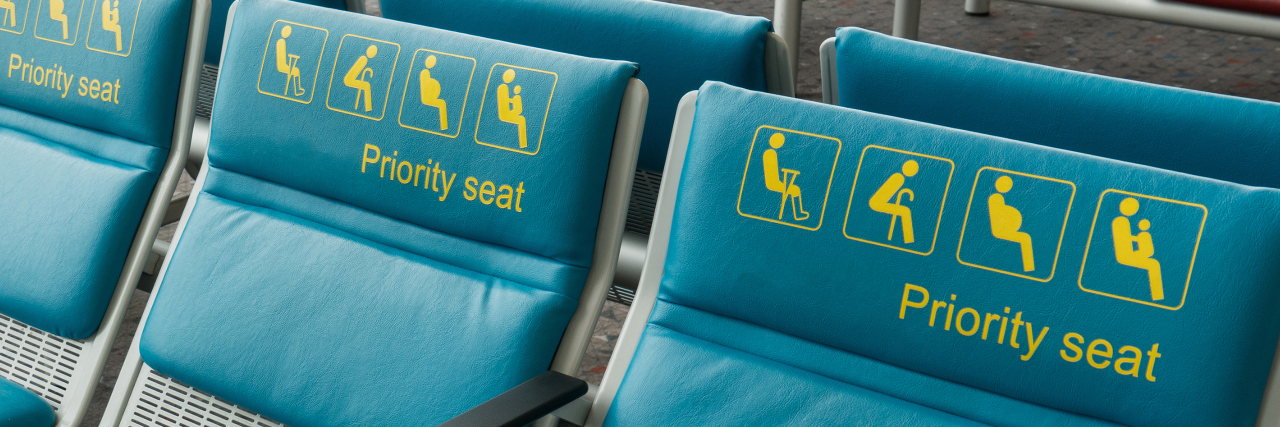All I wanted was to make it to my friend’s graduation party in one piece.
After a painful fall at a job interview one day prior, I was looking forward to a blissful, uninterrupted six-hour train ride. No distractions, no obligations and a celebration for my college best friend at the end of it all. Everything was going to go perfectly.
But by the time the train arrived at the station, my left ankle was throbbing, burning. I could practically feel my ankle swelling as I hobbled towards the train, attempting to place as little weight as possible on my left leg.
The moment I spotted the luggage rack on the lower level of the train, I was faced with a dilemma: Should I lift my suitcase onto the rack, and as per usual, haul the rest of my cargo to the upper level of the train? Or should I stay on the lower level, which was plastered with reminders to “Please Save These Seats for the Elderly and Disabled?”
I gazed longingly up at the steep, narrow flight of stairs leading precariously to the upper level of the train. With my cerebral palsy, the trek to the top of the train with my luggage in tow is challenging as is; there was absolutely no way I could make it with my ankle in such intense pain. Reluctantly, I limped over to the lower-level seats, where at 21 years old, I was indubitably the youngest passenger.
I sat down in an aisle seat by a woman wearing a wrist brace, feeling anxiously out of place and worrying that someone, whether it be a train employee or another passenger, would question my use of a “disability” seat. Although I was limping from the pain in my cerebral palsy-affected ankle, my cerebral palsy is typically too mild to be noticeable, and, seated I would look just like any other passenger, only noticeably younger. I was keenly aware that people often incorrectly presume 20-somethings are “too young to be disabled,” despite the fact that I, and so many others, have been living with medical conditions since birth.
To my surprise, the woman seated beside me seemed too engulfed in her own thoughts to question why I was sitting in the disability section of the train. But in the middle of the train ride, the inevitable question arrived.
“Why are you sitting here?”
By her tone alone, I could practically hear the questions swirling through her mind.
She looks able-bodied! And young! Is she just being lazy? Why would she take an accessible seat away from a passenger who really needs it?
I simultaneously felt frustrated by being forced to prove my need for a “disability” seat and highly amused that despite both my cerebral palsy and my ankle wrap, she hadn’t even noticed I was disabled. I breathed a sigh of relief that my ankle injury had given me an “out,” that I wasn’t thrust into the uncomfortable position of disclosing my cerebral palsy to a complete stranger.
I swiveled my ankle towards her so she could clearly see the wrap spiraling up my leg. As calmly as I could muster through my mounting frustration, I replied, “I injured my ankle yesterday. I just can’t walk up the stairs today because I’m in too much pain.”
Satisfied with my response, she said, somewhat frantically, “I’m so sorry! I didn’t know… I hope it’s doing better now!” and we resumed our train ride in peace. But I was haunted by our interaction, by the fact that I was forced to justify my need for a “disability” seat based on my appearance alone. It seemed so wrong that some people are routinely pressured to disclose their medical conditions to strangers because of the pervasive assumption that disability has a particular “look.”
Disability comes in all forms and is often invisible, so do not pressure anyone into disclosing their medical history, assume what any given person requires or judge people with invisible disabilities for using the resources to which they’re legally entitled. Know that when you interrogate a person with an invisible disability about why they’re seated in a particular area, parked in an accessible space or using an accessible restroom stall, you’re pressuring them to disclose private information — their medical history. Don’t expect people with disabilities to prove they’re disabled just to appease you, and refrain from judging others when you don’t know their medical requirements.
Whether you’re “just curious” or you’re legitimately concerned that someone is taking advantage of an accessible area, remember disability does not have a “look,” you are not entitled to receive anyone’s medical history and you should never ask anyone to prove or justify their needs. By showing respect for those with invisible disabilities and their medical needs, you’re paving the way for everyone to have a more comfortable ride through life.
Getty image by Wittayayut.

